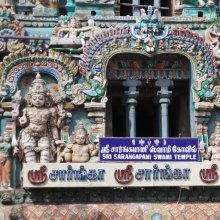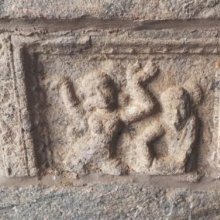Graha: 41 definitions
Introduction:
Graha means something in Buddhism, Pali, Hinduism, Sanskrit, Jainism, Prakrit, the history of ancient India, Marathi, Hindi. If you want to know the exact meaning, history, etymology or English translation of this term then check out the descriptions on this page. Add your comment or reference to a book if you want to contribute to this summary article.
Images (photo gallery)
(+45 more images available)
In Hinduism
Jyotisha (astronomy and astrology)
Source: Wisdom Library: Brihat Samhita by VarahamihiraGraha (ग्रह) refers to the “planets”, according to the Bṛhatsaṃhitā (chapter 2), an encyclopedic Sanskrit work written by Varāhamihira mainly focusing on the science of ancient Indian astronomy astronomy (Jyotiṣa).—Accordingly, “A true Astrologer is also one who has thoroughly mastered the Science of Saṃhitā. It treats of the motions of the sun and planets [i.e., graha]; of their size, color, rays, brilliancy and shape and changes in the same of their disappearance and re-appearance; of their courses and deviations therefrom; of their retrograde and reretrograde motions; of their conjunction with the stars and of their places among the stars and the like”.
Source: Google Books: Studies in the History of the Exact Sciences (Astronomy)Graha (ग्रह, “planet”) refers to “heavenly bodies”.—The concept of graha as ‘heavenly body’ experienced at least the following stages of development.—[...] Five planets were regarded as grahas because they possess man and do him harm. The Sun and the Moon joined the grahas, and a group of seven grahas—or nine grahas including Rāhu and Ketu—was established, although the order of enumeration was not yet fixed. The week-day order of the seven grahas (Sun, Moon, Mars, Mercury, Jupiter, Venus, Saturn) and the group of the nine grahas were established.
Note: In Sanskrit texts, when ‘five planets’ excluding the Sun and the Moon are specifically intended, they are called tārāgraha (‘star-planets’) or aṅgārakādi (‘those which begin with Mars’).
Source: WikiPedia: Hindu AstrologyNine grahas (Navagrahas) are used. The Nine Planets of Vedic Astrology or Jyotiṣa are the forces that capture or eclipse the mind and the decision making of the human being-thus the term 'Graha'. When the Grahas are active in their Daśās or periodicities they are particularly empowered to direct the affairs of the person or the inanimate being as the case may be. Even otherwise, Grahas are always busy capturing us in some way or other, for better or for worse.
etymology: graha; from Grah (Devanāgarī: ग्रह, Sanskrit: graha, 'seizing, laying hold of, holding')
Source: Wikibooks (hi): Sanskrit Technical TermsGraha (ग्रह).—Planet. Note: Graha is a Sanskrit technical term used in ancient Indian sciences such as Astronomy, Mathematics and Geometry.

Jyotisha (ज्योतिष, jyotiṣa or jyotish) refers to ‘astronomy’ or “Vedic astrology” and represents the fifth of the six Vedangas (additional sciences to be studied along with the Vedas). Jyotisha concerns itself with the study and prediction of the movements of celestial bodies, in order to calculate the auspicious time for rituals and ceremonies.
Ayurveda (science of life)
Source: archive.org: Sushruta samhita, Volume IIIThese malignant stars (Graha) or demons affect the person of a child in the cases where the directions laid down before (in the Śārira-sthāna) in respect of the conduct of the mother or the nurse during the time the child is brought-up on the breast are not followed, and consequently where proper benedictory rites are not performed and the child is allowed to remain in an uncleanly state, or where the child becoming anyhow uneasy gets frightened, is rebuked, or begins to cry.
The influences of malignant stars (Graha) or demons (that cause the diseases of infancy) number nine in all and are called
- Skanda-graha,
- Skandapasmara-graha,
- Shakuni-graha,
- Revati-graha,
- Putana-graha,
- Andha-putana-graha,
- Shita-putana-graha,
- Mukha-mandika-graha,
- and Naigamesha-graha or Pitri-graha.
Graha (ग्रह) refers to the planets (i.e., “all celestial bodies seeming to have a motion of their own among the fixed stars”), and is mentioned in verse 1.31 of the Aṣṭāṅgahṛdayasaṃhitā (Sūtrasthāna) by Vāgbhaṭa.—The term graha (~gza) was used by the Indians, just as the corresponding πλάνης; by the Greeks, not only for the planets proper (Mercury, Venus, Mars, Jupiter, and Saturn), but also for the sun and moon. It denotes, in other words, all celestial bodies seeming to have a motion of their own among the fixed stars; the sun answers this description in so far as it moves between the tropics of Cancer and Capricorn and travels through the zodiac from west to east. Occasionally, the ascending and descending nodes of the moon (i.e. the two intersecting points of the lunar orbit and ecliptic passed as the moon goes north and south respectively) were reckoned among the planets as well, whence graha and gza may symbolize the number “nine”.—Instead of gza CD read bza, which is unauthenticated in this meaning.
Source: gurumukhi.ru: Ayurveda glossary of termsGraha (ग्रह):—Stiffness, Retention, Chocked

Āyurveda (आयुर्वेद, ayurveda) is a branch of Indian science dealing with medicine, herbalism, taxology, anatomy, surgery, alchemy and related topics. Traditional practice of Āyurveda in ancient India dates back to at least the first millenium BC. Literature is commonly written in Sanskrit using various poetic metres.
Vedanta (school of philosophy)
Source: archive.org: VivekachudamaniGraha in Sanskrit means both ‘planet’ and ‘seizure.’ The eclipses of the sun and moon are popularly ascribed by Hindu mythology to the periodical attacks by their enemy Rahu, a demon whom they prevented from drinking the nectar.

Vedanta (वेदान्त, vedānta) refers to a school of orthodox Hindu philosophy (astika), drawing its subject-matter from the Upanishads. There are a number of sub-schools of Vedanta, however all of them expound on the basic teaching of the ultimate reality (brahman) and liberation (moksha) of the individual soul (atman).
Purana and Itihasa (epic history)
Source: archive.org: Shiva Purana - English TranslationGraha (ग्रह) refers to the “planets”, according to the Śivapurāṇa 2.3.6.—Accordingly, after the Gods eulogised Goddess Śivā:—“Thus eulogising, in many ways, the great goddess stationed in the womb, the gods returned to their abodes, highly delighted in their minds. When nine months were completed, in the tenth month, the goddess, the mother of the universe, bore all the states of a child in the womb in the complete form. The time was good. The planets, stars [i.e., graha-tāraka] and the luminary heavenly bodies were quiet; the sky was clear and there was brilliance in all the quarters. [...]”.
Source: Cologne Digital Sanskrit Dictionaries: The Purana Index1a) Graha (ग्रह).—A Parā god.*
- * Brahmāṇḍa-purāṇa IV. 1. 57.
1b) Planets, seven in number excluding Rāhu and Ketu; known as Vaimānikas in the current epoch (Vaivasvata)—Rāhu and Ketu are planets which tease the sun and moon;1 each graha has three sthānas, dakṣiṇa, uttara and madhyama.^2
- * Vāyu-purāṇa 3. 14; 7. 16; 30. 146; 31. 35; 51. 8; 53. 29, 109.
Grāha (ग्राह) refers to “crocodiles” (living in forest-streams), according to the Rāmāyaṇa chapter 2.28. Accordingly:—“[...] soothening with kind words to Sītā, when eyes were blemished with tears, the virtuous Rāma spoke again as follows, for the purpose of waking her turn back: ‘[...] Even streams (sarit) filled with crocodiles (grāha) full of mire are difficult to be crossed by rut elephants also. Hence dwelling in a forest is always very much uncomfortable’”.

The Purana (पुराण, purāṇas) refers to Sanskrit literature preserving ancient India’s vast cultural history, including historical legends, religious ceremonies, various arts and sciences. The eighteen mahapuranas total over 400,000 shlokas (metrical couplets) and date to at least several centuries BCE.
Natyashastra (theatrics and dramaturgy)
Source: Wisdom Library: Nāṭya-śāstraGraha (ग्रह, “seizing”) refers to “the note in which the song begins” and is one of the ten characteristics (gati) of the jāti (melodic class), according to the Nāṭyaśāstra chapter 28. It is also known as grahagati or grahasvara. Jāti refers to a recognized melody-type and can be seen as a precursor to rāgas which replaced them.
According to the Nāṭyaśāstra 28.75, “grahas have been like the aṃśa of all the jātis. That note which is taken up in the beginning of a song is the graha, and is an alternative term for the aṃśa”.

Natyashastra (नाट्यशास्त्र, nāṭyaśāstra) refers to both the ancient Indian tradition (shastra) of performing arts, (natya—theatrics, drama, dance, music), as well as the name of a Sanskrit work dealing with these subjects. It also teaches the rules for composing Dramatic plays (nataka), construction and performance of Theater, and Poetic works (kavya).
Dharmashastra (religious law)
Source: Sacred Texts: The Grihya Sutras, Part 2 (SBE30)Graha (ग्रह) refers to “offerings of Soma”, according to the Āpastamba-yajña-paribhāṣā-sūtras.—“with the Grahas the act should be made to coincide with the Upayāma”. Commentary: “Grahas are offerings of Soma, and likewise the vessels (kamasa) in which the Soma is offered. The Soma is offered with the words ‘‘upayāma-gṛhīto'si’’, and while these words are being uttered, the fluid should be poured out (‘dhārāṃ srāvayet’).”.

Dharmashastra (धर्मशास्त्र, dharmaśāstra) contains the instructions (shastra) regarding religious conduct of livelihood (dharma), ceremonies, jurisprudence (study of law) and more. It is categorized as smriti, an important and authoritative selection of books dealing with the Hindu lifestyle.
Shaktism (Shakta philosophy)
Source: Google Books: ManthanabhairavatantramGraha (ग्रह) refers to “planets”, according to the Bhairavīstotra in the Śrīmatottara-tantra, an expansion of the Kubjikāmatatantra: the earliest popular and most authoritative Tantra of the Kubjikā cult.—Accordingly, “Victory! Victory (to you) O goddess (bhagavatī)! [...] Salutations to you) who bestow the play of freedom and enjoyment by means of all the liturgies (krama) and rites (kriyā) performed in the blissful meetings of great ghosts, demons (vetālas), warlocks (bheruṇḍa), witches (lāmā) and planets (graha)! [...]”

Shakta (शाक्त, śākta) or Shaktism (śāktism) represents a tradition of Hinduism where the Goddess (Devi) is revered and worshipped. Shakta literature includes a range of scriptures, including various Agamas and Tantras, although its roots may be traced back to the Vedas.
Shaivism (Shaiva philosophy)
Source: Brill: Śaivism and the Tantric Traditions (philosophy)Graha (ग्रह) refers to “apprehension (of objects)”, according to Utpaladeva’s Vivṛti on Īśvarapratyabhijñākārikā 1.5.6.—Accordingly, “[...] [If you reply:] “But this [property of being an object] can only belong to [things] that are distinct from manifestation,” what (graha) [of these objects] could there be [if they are distinct from manifestation]? [And] what is this [so-called] annihilation of ordinary human practice [that must inexorably occur according to you] if [objects] are one with phenomena? This is what [the Vṛtti] says in “let [us admit that] they consist in phenomena. [...]”.
Source: SOAS University of London: Protective Rites in the Netra TantraGraha (ग्रह) refers to two groups of supernatural beings (i.e., ‘seizers’ and ‘planets’), that cause illness, according to the Netratantra of Kṣemarāja: a Śaiva text from the 9th century in which Śiva (Bhairava) teaches Pārvatī topics such as metaphysics, cosmology, and soteriology.—The Netratantra’s Second Chapter begins with the goddess Pārvatī’s request that Śiva reveal to her the remedy for the ailments that afflict divine and worldly beings. [...]. Śiva adds to the list of maladies a group of supernatural beings that cause illness: [e.g., Grahas], [...]. That Śiva discusses supernatural beings that cause such disease demonstrates how invisible forces affect the world in observable ways. In order to counter these forces, Śiva reveals another invisible but observable element, mantra.
Graha is mentioned in a list of afflictions (which does not arise in the place and time of the Mantravid), according to verse 19.129-133.

Shaiva (शैव, śaiva) or Shaivism (śaivism) represents a tradition of Hinduism worshiping Shiva as the supreme being. Closely related to Shaktism, Shaiva literature includes a range of scriptures, including Tantras, while the root of this tradition may be traced back to the ancient Vedas.
Ganitashastra (Mathematics and Algebra)
Source: archive.org: Hindu MathematicsGraha (ग्रह) represents the number 9 (nine) in the “word-numeral system” (bhūtasaṃkhyā), which was used in Sanskrit texts dealing with astronomy, mathematics, metrics, as well as in the dates of inscriptions and manuscripts in ancient Indian literature.—A system of expressing numbers by means of words arranged as in the place-value notation was developed and perfected in India in the early centuries of the Christian era. In this system the numerals [e.g., 9—graha] are expressed by names of things, beings or concepts, which, naturally or in accordance with the teaching of the Śāstras, connote numbers.

Ganitashastra (शिल्पशास्त्र, gaṇitaśāstra) refers to the ancient Indian science of mathematics, algebra, number theory, arithmetic, etc. Closely allied with astronomy, both were commonly taught and studied in universities, even since the 1st millennium BCE. Ganita-shastra also includes ritualistic math-books such as the Shulba-sutras.
Gitashastra (science of music)
Source: Shodhganga: Elements of Art and Architecture in the Trtiyakhanda of the Visnudharmottarapurana (gita)Graha (ग्रह) refers to one of the thirteen Jātis or “proper combination of two grāmas” (in Indian music), according to the Kallinātha’s commentary Kalānidhi on the Saṃgītaratnākara.—In the Nāṭyaśāstra, jātis are broadly divided into two types viz., śuddhā and vikṛtā. The Saṃgītaratnākara also agrees on it. But in the Viṣṇudharmottarapurāṇa, the reference about the types of jātis is not found. The Saṃgītaratnākara accepts thirteen kinds of characteristic features of jātis. For example: Graha, which is also accepted by the Nāṭyaśāstra.
Gitashastra (गीतशास्त्र, gītaśāstra) refers to the ancient Indian science of Music (gita or samgita), which is traditionally divided in Vocal music, Instrumental music and Dance (under the jurisdiction of music). The different elements and technical terms are explained in a wide range of (often Sanskrit) literature.
Yoga (school of philosophy)
Source: ORA: Amanaska (king of all yogas): A Critical Edition and Annotated Translation by Jason Birch1) Graha (ग्रह) refers to the “(doctrines of) planets”, according to the Amanaska Yoga treatise dealing with meditation, absorption, yogic powers and liberation.—Accordingly, as Īśvara says to Vāmadeva: “[...] Not by studying the doctrines of scriptural exegesis, logic, planets (graha) and mathematics, nor by the Vedas, Upaniṣads, Dharmaśāstras [and the like]; not even by lexicons nor metre, grammar, poetry nor rhetoric; the sage's attainment of the highest reality is gained only from the oral teachings of his own guru.[...]”.
2) Graha (ग्रह) refers to the “grasping (of sense-objects)”, according to the Amanaska Yoga.—Accordingly, as Īśvara says to Vāmadeva: “[...] The knower of yoga whose inhalation and exhalation have disappeared, whose grasping of [sense] objects (viṣaya-graha) has ceased, and who is motionless and free from [any] undertaking, attains bliss. [This] extraordinary absorption by which all volition has been cut off and in which all movement has ceased, is intelligible [only] to oneself and is beyond the scope of words. [...]”.
3) Grāha (ग्राह) refers to the “crocodiles (of the senses)”, according to the Amanaska Yoga.—Accordingly, as Īśvara says to Vāmadeva: “[...] Just as everything disappears [from view] as the sun sets, so, the whole network of [past] actions dissolves into the no-mind [state]. [The Yogin] who has bathed in the no-mind lake, which is free from the crocodiles of the senses (indriya-grāha) and whose water is free from the wind and pure, obtains the supreme nectar. [...]”.

Yoga is originally considered a branch of Hindu philosophy (astika), but both ancient and modern Yoga combine the physical, mental and spiritual. Yoga teaches various physical techniques also known as āsanas (postures), used for various purposes (eg., meditation, contemplation, relaxation).
In Buddhism
Tibetan Buddhism (Vajrayana or tantric Buddhism)
Source: Wisdom Library: Tibetan BuddhismGraha (ग्रह) refers to a group of deities summoned by the Yamāntaka-mantra and mentioned as attending the teachings in the 6th century Mañjuśrīmūlakalpa: one of the largest Kriyā Tantras devoted to Mañjuśrī (the Bodhisattva of wisdom) representing an encyclopedia of knowledge primarily concerned with ritualistic elements in Buddhism. The teachings in this text originate from Mañjuśrī and were taught to and by Buddha Śākyamuni in the presence of a large audience (including Graha).

Tibetan Buddhism includes schools such as Nyingma, Kadampa, Kagyu and Gelug. Their primary canon of literature is divided in two broad categories: The Kangyur, which consists of Buddha’s words, and the Tengyur, which includes commentaries from various sources. Esotericism and tantra techniques (vajrayāna) are collected indepently.
Mahayana (major branch of Buddhism)
Source: academia.edu: A Study and Translation of the GaganagañjaparipṛcchāGrāha (ग्राह) refers to “grasping”, according to the Gaganagañjaparipṛcchā: the eighth chapter of the Mahāsaṃnipāta (a collection of Mahāyāna Buddhist Sūtras).—Accordingly, “[...] Then again, the Bodhisattva, the great being Gaganagañja uttered these verses to that Bodhisattva, the great being Guṇarājaprabhāsa: ‘(29) [...] The one who delights in the well done (sukṛta) and perfected dharma, who is free from the twofold grasping (dvaya-grāha) of truth or untruth (dharmādharma), and who constantly takes pleasure in the dharma through the excellent concentration, him I ask about the of the space-like subject of mind. [...]’”.

Mahayana (महायान, mahāyāna) is a major branch of Buddhism focusing on the path of a Bodhisattva (spiritual aspirants/ enlightened beings). Extant literature is vast and primarely composed in the Sanskrit language. There are many sūtras of which some of the earliest are the various Prajñāpāramitā sūtras.
In Jainism
General definition (in Jainism)
Source: archive.org: Een Kritische Studie Van Svayambhūdeva’s PaümacariuGraha (ग्रह) participated in the war between Rāma and Rāvaṇa, on the side of the latter, as mentioned in Svayambhūdeva’s Paumacariu (Padmacarita, Paumacariya or Rāmāyaṇapurāṇa) chapter 57ff. Svayambhū or Svayambhūdeva (8th or 9th century) was a Jain householder who probably lived in Karnataka. His work recounts the popular Rāma story as known from the older work Rāmāyaṇa (written by Vālmīki). Various chapters [mentioning Graha] are dedicated to the humongous battle whose armies (known as akṣauhiṇīs) consisted of millions of soldiers, horses and elephants, etc.
Source: Encyclopedia of Jainism: Tattvartha Sutra 4: The celestial beings (deva)Graha (ग्रह, “planets”) refers to a class of “stellar celestial beings” (jyotiṣī), itself a category of devas (celestial beings), according to the 2nd-century Tattvārthasūtra 4.10. What is the duration of existence of planet Jupiter (guru)? It is one pit-measured-period. Mercury revolves 888 yojana above the earth (Citrā) level. It resides three yojana above Venus. Venus is situated three yojana above Mercury. Jupiter revolves three yojana above Venus. Mars revolves three yojana above Jupiter. Saturn revolves three yojana above Mars.What is the duration of existence of planets Mars (maṅgala), Mercury (buddha), Saturn etc? It is half pit-measured-period.
Stellar celestial beings (e.g., Graha) are named after their vehicle which is endowed with shining light. These are called by the significant general name luminaries or stellar.
Source: The University of Sydney: A study of the Twelve Reflections1) Graha (ग्रह) refers to a “planet”, according to the 11th century Jñānārṇava, a treatise on Jain Yoga in roughly 2200 Sanskrit verses composed by Śubhacandra.—Accordingly, “Fool, perceiving this multitude of objects that is continually transitory and you do not understand. This is a planet without any medicine (anauṣadha-graha—grahaḥ ko'yam anauṣadhaḥ)”.
Note: Śubhacandra’s reference to the planets here is because, as Von Glasenapp (1999: 447) indicates, Jainism has accepted that the position the stars (including the nine planets) are in when a person is born exerts a dominating influence on that individual’s fate. Further, the Jains do not see any inconsistency between acceptance of the influence that the stars exert and their belief in the theory of karma. So much can be implied from the terms of this verse.
2) Grāha (ग्राह) refers to “aquatic predators”, according to the Jñānārṇava.—Accordingly, “Rudra, elephants of the quarters, gods, demons, aerial spirits, aquatic predators (grāha), the planets, the Vyantaras, the guardians of the quarters of the sky, the enemies [of Vāsudeva], Hari, Bala, the chief of the snakes, the lord of the discus (i.e. Viṣṇu) and others who are powerful, the wind, the sun, etc. all themselves having come together are not able to protect an embodied soul even for an instant [when death is] initiated by the servants of Yama”.

Jainism is an Indian religion of Dharma whose doctrine revolves around harmlessness (ahimsa) towards every living being. The two major branches (Digambara and Svetambara) of Jainism stimulate self-control (or, shramana, ‘self-reliance’) and spiritual development through a path of peace for the soul to progess to the ultimate goal.
India history and geography
Source: Cologne Digital Sanskrit Dictionaries: Indian Epigraphical GlossaryGraha.—(IE 7-1-2), ‘nine’. (IA 21), seizure; cf. go-graha, cattle-lifting. Cf. sūrya-graha (EI 24), an eclipse of the sun. Note: graha is defined in the “Indian epigraphical glossary” as it can be found on ancient inscriptions commonly written in Sanskrit, Prakrit or Dravidian languages.
Source: Singhi Jain Series: Ratnaprabha-suri’s Kuvalayamala-katha (history)Graha (ग्रह) refers to one of the deities being worshiped in ancient India, as vividly depicted in the Kathās (narrative poems) such as Uddyotanasūri in his 8th-century Kuvalayamālā (a Prakrit Campū, similar to Kāvya poetry).—The Kuvalayamala (779 A.D.) is full of cultural material which gains in value because of the firm date of its composition. [...] Page 256.31-2 ff.: Here is a mixed list of 25 gods and Godlings of all religions. These were worshipped and propitiated to obtain favours. The list includes [e.g., Graha] [...].

The history of India traces the identification of countries, villages, towns and other regions of India, as well as mythology, zoology, royal dynasties, rulers, tribes, local festivities and traditions and regional languages. Ancient India enjoyed religious freedom and encourages the path of Dharma, a concept common to Buddhism, Hinduism, and Jainism.
Languages of India and abroad
Marathi-English dictionary
Source: DDSA: The Molesworth Marathi and English Dictionarygraha (ग्रह).—m (S) Taking, accepting, seizing. 2 Eclipse of the sun or moon; seizure (by Rahu). 3 A planet. There are nine according to Hindu astronomy, and the sun is included. 4 An imp of a particular class. Hence fig. A mischievous, pestilent fellow. 5 A fancy; a conception; an opinion. 6 Tenacity. 7 Apprehension or perception (as of one's meaning); an understanding: apprehension of a sense or an acceptation; believing, receiving, holding.
--- OR ---
grāha (ग्राह).—m S A shark; according to some the Gangetic alligator, according to others, the water-elephant (the hippopotamus). 2 Any large marine animal.
--- OR ---
graha (ग्रह).—. Add:--8 A large marine and rapacious fish, probably, shark.
Source: DDSA: The Aryabhusan school dictionary, Marathi-Englishgraha (ग्रह).—m Taking. A planet. An opinion, fan- cy, prejudice. A mischievous fellow.
--- OR ---
grāha (ग्राह).—m A shark; any large marine ani- mal.
Marathi is an Indo-European language having over 70 million native speakers people in (predominantly) Maharashtra India. Marathi, like many other Indo-Aryan languages, evolved from early forms of Prakrit, which itself is a subset of Sanskrit, one of the most ancient languages of the world.
Sanskrit dictionary
Source: DDSA: The practical Sanskrit-English dictionaryGraha (ग्रह).—[grah-ac]
1) Seizing, grasping, laying hold of, seizure, रुरुधुः कचग्रहैः (rurudhuḥ kacagrahaiḥ) R.19.31.
2) A grip, grasp, hold; विक्रम्य कौशिकं खड्गं मोक्षयित्वा ग्रहं रिपोः (vikramya kauśikaṃ khaḍgaṃ mokṣayitvā grahaṃ ripoḥ) Mahābhārata (Bombay) 3.157.11; कर्कटक- ग्रहात् (karkaṭaka- grahāt) Pañcatantra (Bombay) 1.26.
3) Taking, receiving, accepting; receipt.
4) Stealing, robbing; अङ्गुलीग्रन्थिभेदस्य छेदयेत्प्रथमे ग्रहे (aṅgulīgranthibhedasya chedayetprathame grahe) Manusmṛti 9.277; so गोग्रहः (gograhaḥ).
5) Booty, spoil.
6) Eclipse; see ग्रहण (grahaṇa).
7) A planet, (sometimes more particularly 'Rāhu'; vadhyamāne graheṇātha āditye manyurāviśat Mahābhārata (Bombay) 1.24.7.) (the planets are nine :-sūryaścandro maṅgalaśca budhaścāpi bṛhaspatiḥ | śukraḥ śanaiścaro rāhuḥ ketuśceti grahā nava ||); नक्षत्रताराग्रहसंकुलापि (nakṣatratārāgrahasaṃkulāpi) (rātriḥ) R.6.22;3.13;12.28; गुरुणा स्तनभारेण मुखचन्द्रेण भास्वता । शनैश्चराभ्यां पादाभ्यां रेजे ग्रहमयीव सा (guruṇā stanabhāreṇa mukhacandreṇa bhāsvatā | śanaiścarābhyāṃ pādābhyāṃ reje grahamayīva sā) || Bhartṛhari 1.17.
8) Mentioning; utterance, repeating (as of a name) नामजातिग्रहं त्वेषामभिद्रोहेण कुर्वतः (nāmajātigrahaṃ tveṣāmabhidroheṇa kurvataḥ) Manusmṛti 8.271; Amaruśataka 85.
9) A shark, crocodile.
1) An imp in general.
11) A particular class of evil demons supposed to seize upon children and produce convulsions &c. cf. Mb. Crit. ed. 3.219.26; कृष्णग्रहगृहीतात्मा न वेद जगदीदृशम् (kṛṣṇagrahagṛhītātmā na veda jagadīdṛśam) Bhāgavata 7.4.38.
12) Apprehension, perception; ज्योतिश्चक्षुर्गुणग्रहः (jyotiścakṣurguṇagrahaḥ). ...... श्रोत्रं गुणग्रहः (śrotraṃ guṇagrahaḥ) Bhāgavata 2.1.21-22.
13) An organ or instrument of apprehension; Bṛ. Up.3.2.1.
14) Tenacity, perseverance, persistence; नृणां स्वत्वग्रहो यतः (nṛṇāṃ svatvagraho yataḥ) Bhāgavata 7.14.11.
15) Purpose, design.
16) Favour, patronage.
17) The place of a planet in the fixed zodiac.
18) The number 'nine'.
19) Any state of mind which proceeds from magical influences.
2) A house.
21) A spoonful, ladleful; ग्रहान्त्सोमस्य मिमते द्वादश (grahāntsomasya mimate dvādaśa) Ṛgveda 1.114.5.
22) A ladle or vessel; चमसानां ग्रहाणां च शुद्धिः प्रक्षालनेन तु (camasānāṃ grahāṇāṃ ca śuddhiḥ prakṣālanena tu) Manusmṛti 5.116.
23) The middle of a bow.
24) A movable point in the heavens.
25) Keeping back, obstructing.
26) Taking away, depriving; प्राण° (prāṇa°) Pañcatantra (Bombay) 1.295.
27) Preparation for war; ग्रहोऽवग्रहनिर्बन्धग्रहणेषु रणोद्यमे । सूर्यादौ पूतनादौ च सैंहिकेयेऽपि तत् त्रिषु (graho'vagrahanirbandhagrahaṇeṣu raṇodyame | sūryādau pūtanādau ca saiṃhikeye'pi tat triṣu) | Nm.
28) A guest (atithi); यथा सिद्धस्य चान्नस्य ग्रहायाग्रं प्रदीयते (yathā siddhasya cānnasya grahāyāgraṃ pradīyate) Mahābhārata (Bombay) 13.1.6.
29) Imprisoning, imprisonment; Mahābhārata (Bombay) 13.136.11.
Derivable forms: grahaḥ (ग्रहः).
--- OR ---
Grāha (ग्राह).—a. (-hī f.) [ग्रह् भावे घञ् (grah bhāve ghañ)] Seizing, clutching; taking, holding, receiving &c.
-haḥ 1 Seizing, grasping; हस्तग्राहं तु तं मत्वा (hastagrāhaṃ tu taṃ matvā) Rām.7.34.2.
2) A crocodile, shark; रागग्राहवती (rāgagrāhavatī) Bhartṛhari 3.45.
3) A prisoner.
4) Accepting.
5) Understanding, knowledge.
6) Persistence, importunity; तव मातुरसद्ग्राहं विद्म पूर्वं यथा श्रुतम् (tava māturasadgrāhaṃ vidma pūrvaṃ yathā śrutam) Rām.2.35.18.
7) Determination, resolve; मूढग्राहेणात्मनो यत्पीडया क्रियते तपः (mūḍhagrāheṇātmano yatpīḍayā kriyate tapaḥ) Bhagavadgītā (Bombay) 17.19.
8) A disease.
9) Any large fish or marine animal; जग्राहाजगरो ग्राहो भुजयोरुभयोर्बलात् (jagrāhājagaro grāho bhujayorubhayorbalāt) Mahābhārata (Bombay) 3.178.28; Kirātārjunīya 13.24.
1) Morbid affection, disease.
11) Beginning, undertaking.
12) The handle (of a sword &c.).
13) Paralysis.
-hī A female crocodile.
Source: Cologne Digital Sanskrit Dictionaries: Edgerton Buddhist Hybrid Sanskrit DictionaryGrāha (ग्राह).—(-grāha), ifc., m. (= Pali gāha), (heretical, erroneous) belief (in), holding (to)…: asantagrāhātu (from false be- lief) vimukta bhonti Saddharmapuṇḍarīka 92.9 (verse); especially ātma-grāha (= Pali atta-gāha), clinging to the (false view that there is a) self: Śikṣāsamuccaya 198.20 (bhayāni…) tāny ātmagrāhata ut- padyante; 21 ahaṃ…ātmagrāhaṃ parityajeyaṃ; Laṅkāvatāra-sūtra 177.14 ātmagrāhapatitayā saṃtatyā; Vajracchedikā 23.11—12 and 25.16 ātmagrāho bhavet sattvagrāho jīvagrāhaḥ pudgala- grāho bhavet; similarly Vajracchedikā 42.12; and 42.13 ātmagrāha iti subhūte agrāha eṣa tathāgatena bhāṣitaḥ; 45.4 sa eva piṇḍagrāho 'bhaviṣyat…(5) agrāhaḥ sa tathāgatena bhāṣitaḥ; Lalitavistara 205.8 (lokasya…) ātmanīyagrāhānugamā- nasasya, having minds that follow after the false belief that there is anything peculiar (belonging) to the self.
Source: Cologne Digital Sanskrit Dictionaries: Shabda-Sagara Sanskrit-English DictionaryGraha (ग्रह).—m.
(-haḥ) 1. Taking, whether by seizure or acceptance. 2. An eclipse or seizure of the sun or moon, by Rahu, &c. 3. A planet. 4. The place of a planet in the fixed zodiac. 5. A moveable point in the heavens. 6. A name of Rahu, or the ascending node. 7. An imp, one of a particular class, beginning with Putana, supposed especially to seize upon young children producing convulsions. 8. Effort in battle. 9. Tenacity, perseverance. 10. Purpose, design. 11. Favor, patronage. E. grah to take, &c. affix ac.
--- OR ---
Grāha (ग्राह).—m.
(-haḥ) 1. Taking, either by seizure or acceptance. 2. A shark; according to some, the Gangetic alligator, (Lacerta Gangetica;) according to others, the water elephant, (the hippopotamus.) 3. Any large fish or marine animal. E. grah to take, affix ghañ or ṇa.
Source: Cologne Digital Sanskrit Dictionaries: Benfey Sanskrit-English DictionaryGraha (ग्रह).—[grah + a], I. Latter part of comp. adj. 1. Seizing, [Bhāgavata-Purāṇa, (ed. Burnouf.)] 3, 15, 35. 2. Gathering, [Bhāgavata-Purāṇa, (ed. Burnouf.)] 8, 6, 23. Ii. m. 1. A seizure of the sun or moon by Rāhu, i. e. an eclipse, [Bhartṛhari, (ed. Bohlen.)] 2, 87. 2. A planet, [Mānavadharmaśāstra] 1, 24, 7. 3. The five planets, Mars, Mercury, Jupiter, Venus, and Saturn, combined with Rāhu, Ketu, sun and moon, making nine; it denotes the numeral Nine, Śrutab. 35. 4. An imp, [Suśruta] 2, 382, 4. 5. A crocodile, or shark, [Rāmāyaṇa] 4, 44, 47. 6. Booty, Mahābhārata 3, 11461. 7. A draught, [Bhāgavata-Purāṇa, (ed. Burnouf.)] 4, 13, 30. 8. A vessel, [Mānavadharmaśāstra] 5, 116. 9. The place where a bow is held when strung, Mahābhārata 4, 1351. 10. Gripe, [Pañcatantra] i. [distich] 237. 11. Theft, [Mānavadharmaśāstra] 9, 277. 12. Receipt, [Mānavadharmaśāstra] 8, 180. 13. Mention, [Mānavadharmaśāstra] 8, 271; [Rājataraṅgiṇī] 5, 361. 14. Perception, Bhāṣāp. 58; understanding, [Bhāgavata-Purāṇa, (ed. Burnouf.)] 7, 14, 11. 15. An organ of perception, [Bhāgavata-Purāṇa, (ed. Burnouf.)] 4, 7, 31. 16. Tenacity, perseverance, [Kathāsaritsāgara, (ed. Brockhaus.)] 24, 156; [Pañcatantra] i. [distich] 291 (where grāhas must be changed to grahas).
--- OR ---
Grāha (ग्राह).—i. e. grah + a, I. adj., f. hī, 1. Taking, [Yājñavalkya, (ed. Stenzler.)] 2, 51. 2. Robbing, [Rāmāyaṇa] 4, 41, 38. Ii. m. 1. A shark, [Pañcatantra] i. [distich] 420. f. hī, A female shark, [Rāmāyaṇa] 6, 82, 73. 2. Seizing, seizure; e. g. pāṇi-, Taking the hand at marriage. 3. A fit, a disease, Mahābhārata 6, 5680 (read ūru-). 4. Enterprise, [Bhagavadgītā, (ed. Schlegel.)] 17, 19.
Source: Cologne Digital Sanskrit Dictionaries: Cappeller Sanskrit-English DictionaryGraha (ग्रह).—[adjective] grasping, seizing, etc. (v. grabh).
— [masculine] one who seizes, [especially] the demon Rāhu (who seizes and obscures the moon), a planet or star (as seizing or influencing the destinies of men), demon of illness, crocodile, one of the eight organs, house, vessel for drawing water; anything seized, e.[grammar] booty, prey, ladleful, spoonful, the middle of the bow; seizing, grasp, robbery, theft, tenacity, insisting upon ([locative] or —°); taking, receiving; choice, favour; mention, apprehension, conceiving, understanding.
--- OR ---
Grāha (ग्राह).—[feminine] ī seizing, catching, taking, accepting (—°). [masculine] beast of prey, crocodile, shark, serpent; seizure, grasp, hold, attack, disease; naming, mentioning.
Source: Cologne Digital Sanskrit Dictionaries: Monier-Williams Sanskrit-English Dictionary1) Graha (ग्रह):—[from grah] mfn. ([Pāṇini 3-3, 58]; [gana] vṛṣādi) ifc. ([iii, 2, 9], [vArttika] 1) seizing, laying hold of, holding, [Bhāgavata-purāṇa iii, 15, 35] (cf. aṅkuśa-, dhanur-, etc.)
2) [v.s. ...] obtaining, [v, viii]
3) [v.s. ...] perceiving, recognising, [iv, 7, 31]
4) [v.s. ...] m. ‘seizer (eclipser)’, Rāhu or the dragon’s head, [Mahābhārata] etc.
5) [v.s. ...] a planet (as seizing or influencing the destinies of men in a supernatural manner; sometimes 5 are enumerated, viz. Mars, Mercury, Jupiter, Venus, and Saturn, [Mahābhārata vi, 4566 f.; Rāmāyaṇa i, 19, 2; Raghuvaṃśa iii, 13 etc.]; also 7 id est. the preceding with Rāhu and Ketu, [Mahābhārata vii, 5636]; also 9 id est. the sun cf. [Śatapatha-brāhmaṇa iv, 6, 5, 1 and 5; Mahābhārata xiii, 913; xiv, 1175] and moon with the 7 preceding, [Yājñavalkya i, 295; Mahābhārata iv, 48; Varāha-mihira’s Bṛhat-saṃhitā]; also the polar star is called a Graha, [Garg.] ([Jyotiṣa 5 [Scholiast or Commentator]]); the planets are either auspicious śubha-, sad-, or inauspicious krūra-, pāpa-, [Varāha-mihira’s Bṛhat-saṃhitā]; with Jainas they constitute one of the 5 classes of the Jyotiṣkas)
6) [v.s. ...] the place of a planet in the fixed zodiac, [Horace H. Wilson]
7) [v.s. ...] the number ‘nine’
8) [v.s. ...] Name of particular evil demons or spirits who seize or exercise a bad influence on the body and mind of man (causing insanity etc.; it falls within the province of medical science to expel these demons; those who [especially] seize children and cause convulsions etc. are divided into 9 classes according to the number of planets, [Suśruta]), [Mahābhārata] etc.
9) [v.s. ...] any state which proceeds from magical influences and takes possession of the whole man, [Bhāgavata-purāṇa vii, ix; Brahma-purāṇa; Hitopadeśa ii, 1, 20]
10) [v.s. ...] m. a crocodile, [Mahābhārata xvi, 142] (ifc. f(ā). ), [Rāmāyaṇa iv f.; Bhāgavata-purāṇa viii]
11) [v.s. ...] m. any ladle or vessel employed for taking up a portion of fluid ([especially] of Soma) out of a larger vessel, [Manu-smṛti v, 116; Yājñavalkya i, 182]
12) [v.s. ...] Name of the 8 organs of perception (viz. the 5 organs of sense with Manas, the hands and the voice), [Śatapatha-brāhmaṇa xiv; Nṛsiṃha-tāpanīya-upaniṣad i, 4, 3, 22]
13) [v.s. ...] (= gṛha) a house, [Rāmāyaṇa vii, 40, 30] (cf. a-, khara-, -druma and -pati)
14) [v.s. ...] ‘anything seized’, spoil, booty, [Mahābhārata iii, 11461] (cf. hāluñcana)
15) [v.s. ...] as much as can be taken with a ladle or spoon out of a larger vessel, ladleful, spoonful ([especially] of Soma), [Ṛg-veda x, 114, 5; Vājasaneyi-saṃhitā; Taittirīya-saṃhitā; Aitareya-brāhmaṇa; Śatapatha-brāhmaṇa] etc.
16) [v.s. ...] the middle of a bow or that part which is grasped when the bow is used, [Mahābhārata iv, 1351] (su-, [1326])
17) [v.s. ...] the beginning of any piece of music
18) [v.s. ...] grasp, seizing, laying hold of (often ifc.), [Kauśika-sūtra 10; Mahābhārata] etc.
19) [v.s. ...] keeping back, obstructing, [Suśruta]
20) [v.s. ...] imprisoning, imprisonment (haṃ-√gam, ‘to become a prisoner’ [Kāmandakīya-nītisāra]), [Rāmāyaṇa ii, 58, 2]
21) [v.s. ...] seizure (by demons causing diseases e.g. aṅga-, spasm of the limbs), [Suśruta]
22) [v.s. ...] seizure of the sun and moon, eclipse, [Atharva-veda xix, 9, 7 and 10; Varāha-mihira’s Bṛhat-saṃhitā]
23) [v.s. ...] stealing, robbing, [Manu-smṛti ix, 277; Mahābhārata vi, 4458]
24) [v.s. ...] effort, [Hitopadeśa]
25) [v.s. ...] insisting upon, tenacity, perseverance in ([locative case] or in [compound]), [Bhāgavata-purāṇa vii, 14, 11; Naiṣadha-carita ix, 12; Kathāsaritsāgara; Rājataraṅgiṇī viii, 226]
26) [v.s. ...] taking, receiving, reception, [Manu-smṛti viii, 180; Śṛṅgāra-tilaka]
27) [v.s. ...] taking up (any fluid)
28) [v.s. ...] choosing, [Mahābhārata xii, 83, 12; Sāhitya-darpaṇa vi, 136]
29) [v.s. ...] ‘favour’ See -nigraha
30) [v.s. ...] mentioning, employing (a word), [Manu-smṛti viii, 271; Pāṇini 7-1, 21], [Kāraṇḍa-vyūha 2; Amaru-śataka; Rājataraṅgiṇī]
31) [v.s. ...] apprehension, perception, understanding, [Bhāṣāpariccheda; Bhāgavata-purāṇa; Sarvadarśana-saṃgraha [Scholiast or Commentator] on Jaimini] and, [Kapila’s Sāṃkhya-pravacana]
32) Grāha (ग्राह):—[from grah] a mf(ī)n. ([Pāṇini 3-1, 143]) ifc. seizing, holding, catching, receiving, [Yājñavalkya ii, 51; Rāmāyaṇa iv, 41, 38]
33) [v.s. ...] taking (a wife), [Yājñavalkya ii, 51] (cf. karṇa-, gila-, dhanur-, pāṇi-, pārṣṇi-, vandi-, vyāla-, hasta-)
34) [v.s. ...] m. a rapacious animal living in fresh or sea water, any large fish or marine animal (crocodile, shark, serpent, Gangetic alligator, water elephant, or hippopotamus), [Manu-smṛti vi, 78; Mahābhārata] etc. (ifc. f(ā). , [iv, 2017; xvi; Rāmāyaṇa ii])
35) [v.s. ...] m. a prisoner, [cf. Lexicographers, esp. such as amarasiṃha, halāyudha, hemacandra, etc.]
36) [v.s. ...] the handle (of a sword etc.), [Demetrius Galanos’s Lexiko: sanskritikes, anglikes, hellenikes]
37) [v.s. ...] seizure, grasping, laying hold of [Pañcatantra i, 10, 1] ([varia lectio] for graha)
38) [v.s. ...] morbid affection, disease, [Śatapatha-brāhmaṇa iii]
39) [v.s. ...] paralysis (of the thigh, ūru-grāha, [Atharva-veda xi, 9, 12] [ur [manuscripts]] [Mahābhārata v, 2024 and vi, 5680])
40) [v.s. ...] ‘mentioning’ See nāma-
41) [v.s. ...] fiction, whim, [Bhagavad-gītā xvii, 19]
42) [v.s. ...] conception, notion of (in [compound]), [Vajracchedikā 6 and 9]
43) b haka, etc. See √grah.
Source: Cologne Digital Sanskrit Dictionaries: Yates Sanskrit-English Dictionary1) Graha (ग्रह):—(haḥ) 1. m. Taking; an eclipse; a planet; Rāhu; an imp; effort; tenacity; design; favour.
2) Grāha (ग्राह):—(haḥ) 1. m. Taking; a shark.
Source: DDSA: Paia-sadda-mahannavo; a comprehensive Prakrit Hindi dictionary (S)Graha (ग्रह) in the Sanskrit language is related to the Prakrit words: Gaha, Gāha.
[Sanskrit to German]
Sanskrit, also spelled संस्कृतम् (saṃskṛtam), is an ancient language of India commonly seen as the grandmother of the Indo-European language family (even English!). Closely allied with Prakrit and Pali, Sanskrit is more exhaustive in both grammar and terms and has the most extensive collection of literature in the world, greatly surpassing its sister-languages Greek and Latin.
Hindi dictionary
Source: DDSA: A practical Hindi-English dictionary1) Graha (ग्रह) [Also spelled grah]:—(nm) a planet; ~[ha-grasta] planet-stricken; ~[ha-śāṃti] countering of evil planetary effects; ~[hīya] planetary.
2) Grāha (ग्राह) [Also spelled grah]:—(nm) a crocodile.
...
Kannada-English dictionary
Source: Alar: Kannada-English corpusGraha (ಗ್ರಹ):—
1) [noun] seizure a) the act of one who seizes or an instance of this; b) the state or an instance of being seized.
2) [noun] the act of receiving (something from another).
3) [noun] (myth.) Rāhu or Kētu, either of the two demons who are supposed to eclipse the sun or moon by swallowing them.
4) [noun] a large, opaque, non-luminous mass, usu. with its own moons, that revolves about a star; esp. any of the sun’s nine major planets - Mercury, Venus, Earth, Mars, Jupiter, Saturn, Uranus, Neptune, and Pluto; a planet.
5) [noun] (astrol.) any of the nine celestial bodies, as the Sun, Moon, Mars, Mercury, Jupiter, Venus, Saturn, Rāhu and Kētu, thought of as influencing human lives.
6) [noun] any of the evil spirits that are supposed to possess human.
7) [noun] the condition of being possessed by an evil spirit.
8) [noun] a Brahmaṇa.
9) [noun] the earth.
10) [noun] the living beings collectively.
11) [noun] the symbol for the number nine.
12) [noun] a dwelling place; a house.
13) [noun] (mus.) a note with which a rāga (musical mode) is begun or must be begun with.
--- OR ---
Grāha (ಗ್ರಾಹ):—
1) [noun] the act of one who seizes or an instance of this; seizure; holding.
2) [noun] the act of receiving (something from another).
3) [noun] any rapacious animal, chiefly living in water, as crocodile, shark, hippopotamus, etc.
4) [noun] (myth.) name of a hell.
Kannada is a Dravidian language (as opposed to the Indo-European language family) mainly spoken in the southwestern region of India.
See also (Relevant definitions)
Starts with (+284): Grahabadha, Grahabadhe, Grahabala, Grahabali, Grahabhakti, Grahabhavadhyaya, Grahabhavaphala, Grahabhavaprakasha, Grahabhidhana, Grahabhita, Grahabhite, Grahabhitijit, Grahabhojana, Grahacara, Grahacaratika, Grahacarita, Grahacaritavid, Grahacchidra, Grahaceshtavidhana, Grahachintaka.
Ends with (+1107): Abhigraha, Abhyantara-parigraha, Acarasamgraha, Adarshagraha, Adbhutasamgraha, Adbhutasarasamgraha, Adharagraha, Adhikaranarthasamgraha, Adhikarasamgraha, Adidharmasarasamgraha, Adityagraha, Adrishtavigraha, Advaitabrahmasiddhiviniyogasamgraha, Advaitamakarandasamgraha, Advaitanirnayasamgraha, Advaitasamgraha, Advaitavaidikasiddhantasamgraha, Advayavigraha, Adyagraha, Agamasarasamgraha.
Full-text (+1390): Namagraha, Panigraha, Gaha, Atigraha, Grahapuja, Parshnigraha, Navagraha, Mudhagraha, Karnagraha, Tushagraha, Sutragraha, Ghatigraha, Karagraha, Gograha, Ankushagraha, Urugraha, Grahayaga, Grahamaya, Rahugraha, Hradagraha.
Relevant text
Search found 107 books and stories containing Graha, Grāha; (plurals include: Grahas, Grāhas). You can also click to the full overview containing English textual excerpts. Below are direct links for the most relevant articles:
Brihadaranyaka Upanishad (by Swāmī Mādhavānanda)
Section II - Yajnavalkya and Artabhaga < [Chapter III]
Section IV - Yajnavalkya and Ushasta < [Chapter III]
Section III - Yajnavalkya and Bhujyu < [Chapter III]
Satapatha-brahmana (by Julius Eggeling)
Kāṇḍa IV, adhyāya 6, brāhmaṇa 5 < [Fourth Kāṇḍa]
Kāṇḍa IV, adhyāya 1, brāhmaṇa 2 < [Fourth Kāṇḍa]
Kāṇḍa IV, adhyāya 6, brāhmaṇa 1 < [Fourth Kāṇḍa]
Vakyapadiya of Bhartrihari (by K. A. Subramania Iyer)
Verse 3.1.58-59 < [Book 3 - Pada-kāṇḍa (1): Jāti-samuddeśa (On the Universal)]
Verse 3.1.50 < [Book 3 - Pada-kāṇḍa (1): Jāti-samuddeśa (On the Universal)]
Verse 2.19 < [Book 2 - Vākya-kāṇḍa]
Rivers in Ancient India (study) (by Archana Sarma)
2(c). Sarasvatī and Sārasvata < [Chapter 2 - The Rivers in the Saṃhitā Literature]
Sushruta Samhita, Volume 6: Uttara-tantra (by Kaviraj Kunja Lal Bhishagratna)
Chapter LX - Symptoms and Treatment of demonology (Amanusha) < [Canto IV - Bhuta-vidya-tantra (psychology and psychiatry)]
Chapter XXVII - Specific features of nine malignant Grahas < [Canto II - Kaumarabhritya-tantra (pediatrics, gynecology and pregnancy)]
Chapter XXXVII - Origin of nine Grahas < [Canto II - Kaumarabhritya-tantra (pediatrics, gynecology and pregnancy)]
Charaka Samhita and Sushruta Samhita (by Nayana Sharma)
Bhūtas and Grahas < [Chapter 8]
Disease as an entity or as a process < [Chapter 4]
Practice of Therapeutics < [Chapter 4]
Related products








